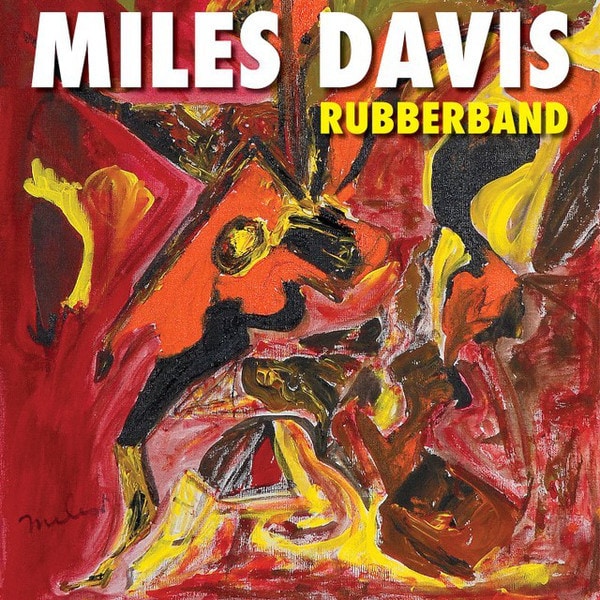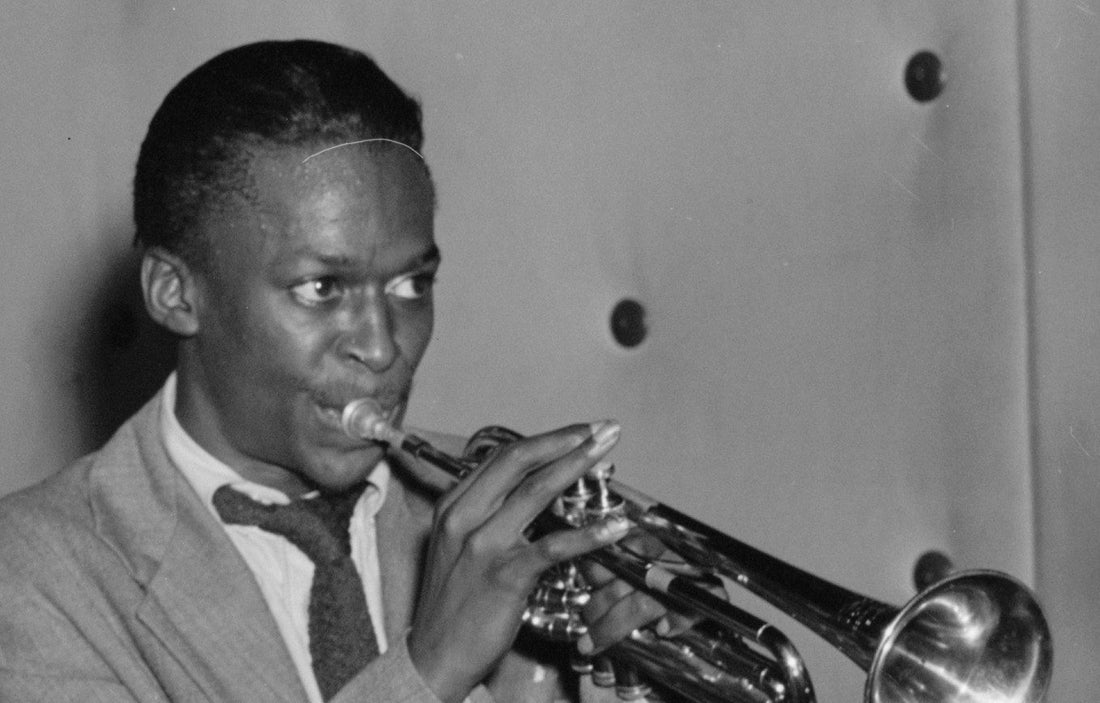Here’s something you don’t hear every day: Miles Davis has a new album! Yes, the great trumpeter has been dead since 1991, but his record Rubberband was just released this September. And while we’re celebrating, 2019 also marks the 50th anniversary of the famed Bitches Brew album.
In 1944, as a teen trumpeter in St. Louis, Davis was tapped to fill in for Art Blakey at a Billy Eckstine concert, and the pros encouraged him. So, that same year he headed to New York to study at the Juilliard School. But Charlie Parker liked his style enough to hire him, and he quickly left school for a real-life education.
Davis’ innovations spread across the subgenres of cool jazz and outgrowths of bebop. He influenced a couple of generations of players, and – just as important – he allowed himself to be influenced by younger musicians, even outside of jazz. He was an outspoken fan of Jimi Hendrix, for example, and later he championed Michael Jackson’s music.
It was tougher than usual to choose which cuts to feature here. Davis made over 50 studio records. All I could do was cherry-pick from among this impressive harvest. Enjoy these eight great tracks from Miles Davis.
- “Bluing”

Bluing
Prestige
1951
Many of us remember the influx of EP albums in the 1980s. But 30 years before that, the jazz music industry used 10-inch LPs to release singles in a genre where tunes could go on for quite a while. From 1951, the 10-minute “Bluing” is so long that it had to be split over the two sides of the disc.
Supported by the delicate touch of Walter Bishop on piano, plus four other top-notch musicians (Sonny Rollins, Tommy Potter, Art Blakey, and Jackie McLean), “Bluing” is a great example of Davis’ more gentle bop style before it took a hard turn.
- “Blue ‘n’ Boogie”

Miles Davis All-Star Sextet
Prestige
1954
On this 10-inch LP, Side A is the 1944 Dizzy Gillespie tune “Blue ‘n’ Boogie.” In an interview, Davis once explained that his goal on this track was to combine a funky blues sound with the “fire and improvisation of bebop.” He was certainly the guy to do it.
Besides the raucous drumming of Kenny Clarke and Davis’ lithe solos, the other sextet members contribute equally. Percy Heath’s walking bassline is practically skipping down the sidewalk. Starting at 2:00 J.J. Johnson shows that a trombone can be a virtuoso instrument (a special treat, since the Davis Quintet had no trombone). Horace Silver is on piano and Lucky Thompson on tenor sax.
- “Oleo”

Bags’ Groove
Prestige
1957
Longtime Davis collaborator Sonny Rollins wrote “Oleo” and plays tenor sax on the album Bags’ Groove (the title track refers to a Milt Jackson tune written a few years before). Rollins’ composition premiered on this record, and grew into a hard bop standard.
The Davis All-Stars (as the quintet is sometimes referred to) is made up of inventors of hard bop, a term that incorporates musical features that should be in conflict but work well together: uneven-length of phrases, dissonance, and a strong gospel-like swing rhythm. Davis’ playing is sly and charming.
- “Drad-Dog”

Someday My Prince Will Come
Columbia
1961
One of the draws of Someday My Prince Will Come is the presence of tenor sax player Hank Mobley in his only record with the Davis Quintet. John Coltrane, who plays only on one track, gets billed above Mobley on the cover; Columbia knew what would sell. But Mobley proves an apt partner for Davis’ musical vision. Too bad they didn’t work together more.
The sultry “Dread-Dog,” a Davis composition, opens with a slow, misty solo on muted trumpet, matched in style by Mobley’s horn starting at 1:22.
- “Pinocchio”

Nefertiti
Columbia
1968
Wayne Shorter and Herbie Hancock wrote most of the celebrated album Nefertiti. The personnel comprise what is known as the Davis Second Great Quintet: Davis on trumpet, Hancock on piano, Shorter on tenor sax, Ron Carter on bass, and Tony Williams on drums. That fivesome is credited with inventing the dissonant small-group style of “post-bop.”
Shorter wrote “Pinocchio,” and throughout the first playing of the long, complex melody he perfectly doubles Davis’ laid-back line at the lower octave. They make it sound like as easy as playing catch in the back yard.
- “Sweet Pea”

Water Babies
Columbia
1976
Since Davis sometimes had a habit of showing up in the studio to record random tracks, some of his albums took a while to coalesce, and sometimes not even under his own guidance. Water Babies was one of those. When Davis announced he was retiring in 1975, producers at Columbia Records started sweeping the vaults for material to put in a farewell album.
Of course, Davis didn’t end up retiring for long, but his temporary rest did the jazz world a favor by bringing out a bunch of tunes it might not have heard otherwise. Water Babies is a combination of tracks recorded by the quintet in 1967-68, mostly outtakes from earlier albums.
“Sweet Pea” was composed by Wayne Shorter. It’s a wandering slow ballad. Davis’ trumpet plays the role of a lovelorn man, sometimes whimpering, sometimes sobbing, sometimes wailing in desperation. Its interactions with Herbie Hancock’s piano and Roy Carter’s punctuating bassline give the piece the texture of etched porcelain.
- “Come Get It”

Star People
Columbia
1983
Mino Cinélu is the real treasure of the Star People album. This French jazz percussionist has a thrilling touch on hand-struck drums, one of those players who really understands the subtleties of energy, accent, and pitch in percussion.
“Come Get It” starts with the sound of Cinélu’s congas. Drum set (Al Foster) quickly joins in, bringing the sound more solidly into the jazz realm. The guitar and bass groove is laid in so deep that Davis doesn’t even deign to come in until around 2:20, subtly at first, like he’s testing out whether he belongs in the room. Yeah, he does, and his hard-bop solo will make your hair stand on end.
httpv://en.wikipedia.org/wiki/Star_People
- “This Is It”

Rubberband
Rhino Entertainment
2019
In 1985, after 30 years with Columbia Records, Davis suddenly left them and signed with Warner Bros. Apparently he had vague ideas of starting with jazz versions of pop and R&B tunes, as he’d done on his final Columbia album, You’re Under Arrest. But Davis was listless and unfocused in the studio, only laying down a track every few months. So the head of studio, Tommy LiPuma, stepped in, and had bassist Marcus Miller write a bunch of jazz tunes for Davis.
The result was an album called Tutu. And the earlier jazzed-up pop tracks were shelved. Three came out in a box set in 1992. This new album contains those, plus eight more. The funk-infused “This Is It” has a terrifying edginess that proves this album was worth bringing back up from the crypt. The wild guitar line is played by Mike Stern.



